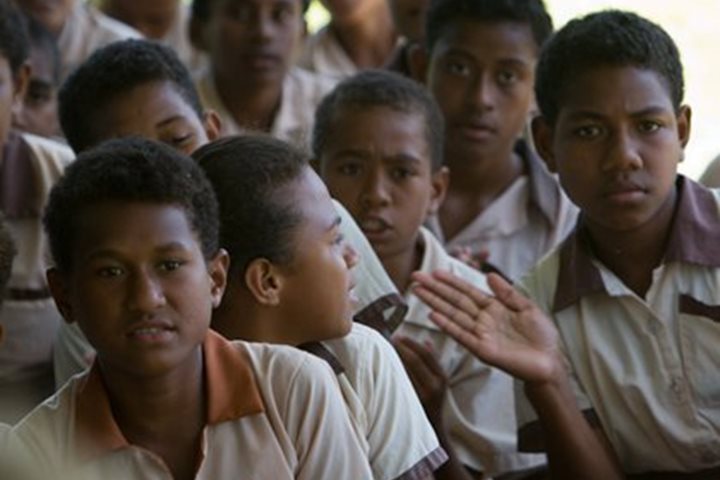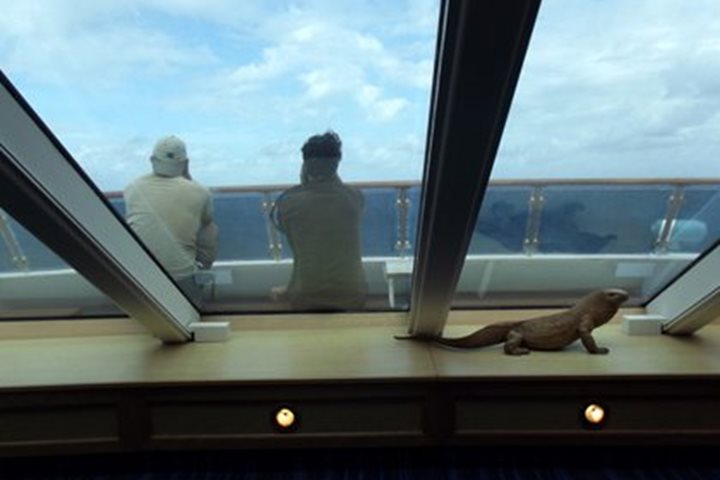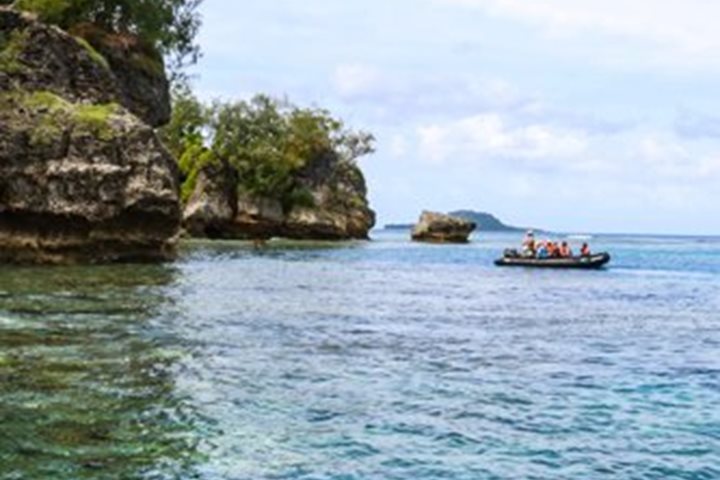The early morning rain cleared as we ate our breakfast. A beautiful sunny day was beginning by the time we went ashore at Owa Raja, the island in the southern Solomons that had been named Santa Ana by Spanish explorers. The Zodiacs carried us in through a wide channel in the fringing reef where small breakers were curling over the coral and the water beneath our boats changed from the glorious royal blue of the deeps to the glowing turquoise of the shallow lagoon.
Upon landing we were treated to a typical Melanesian “threat welcome.” Ferocious warriors rushed out of the palms to confront us and, having determined that our intentions were friendly, withdrew again. Now we could walk up the beach to meet the rest of the villagers, strolling past flower-decked poles and woven palm decorations before receiving beautiful leis that made our welcome complete.
Walking through the village, we had a chance to shop for crafts and artifacts on our way to an impromptu seating area by the field where several traditional dances would be performed for us. Under a bright overcast sky, perfect for photography, a panpipe band featuring instruments of both wind and percussion got things off to a lively start before the brightly-costumed dancers took the stage. Several troops of men and women sang and danced for us, performing a repertoire that contrasted serious pieces with others that seemed quite ribald. Everyone had a great time, not least the many villagers who had turned out to watch with us.
Following the dances we went our separate ways, gathering for hikes across the island or wandering through the village for more photography, shopping or to look in on National Geographic photographer Chris Rainier, who was conducting a digital media workshop with young students and elders from the island. With the cameras and computers he brought and with instruction from him and Ralph Lee Hopkins, our Director of Expedition Photography, the islanders were invited to document their lives and record the voices, language, and stories of their elders.
The hiking was hot as we began but soon we climbed up to the uplifted coral limestone plateau that forms the core of the island and there we found a delicious sea breezed blowing. One of our groups stopped for a visit at a smaller village while the rest of us continued to yet another one. It was a lovely and very traditional community, where we were permitted to visit the Spirit House. In two A-frame shelters of wood, palm thatch, and coral rock we found a truly remarkable collection of offering bowls, reed packets containing various bones (including a few with skulls staring out), and a number of amazing coffins, carved as canoes and tuna and made to contain the bones of revered ancestors. Although no burials are being conducted there now, these unique graves of important chiefs of past years are still held in reverence by the people of the village and we felt very honored to be allowed to visit them.
Before very long we were back in the comfort of the National Geographic Orion, enjoying a hearty lunch and a bit of rest before the activities of the afternoon. And those activities were the perfect sequel to the morning: a chance to slip into the cool blue water and snorkel along the crest of the beautiful, healthy reef that surrounds the island. We moved slowly, scanning the many species of coral and bright, flashing fish as we swam or rode the glass-bottomed boat and enjoyed the other face of Owa Raha, a realm of wildlife even more ancient and just as vital as the friendly communities that had welcomed us ashore in the morning.







